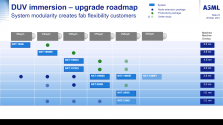Summary
1. Planar Grating Laser Interferometer has been delayed by 2 years.
2. Fortunately, Harbin Institute of Technology got it done at the end of last year.
3. Now 28nm Lithography double exposure supports 14nm process。
消息人士透露,虽然比原计划推迟了2年,但是目前进展已经顺利。
大家都知道,所谓的0贰砖项的GKJ,就是28nm制程节点的GKJ。按照项目目标规定,该GKJ只能用于28nm节点,无法通过多重曝光应用于14nm节点。
虽然都是采用duv光源的浸润式原理的机器,但是14nm比28nm的机器的各项精度都要提升,其中最重要的技术难点就是GKJ内部测量的定位精度要大幅提高,因此14nmGKJ的内部测量仪器就必须从28nmGKJ的多轴激光干涉仪,升级为平面光栅激光干涉仪,只有这样才能满足掩模工件台、硅片双工件台和投影物镜之间复杂的相对位置、姿态测量需求,保证光刻机的整体套刻精度。
2023年之前,这个平面光栅激光干涉仪没有搞定,所以GKJ也就是28nm节点适用,无法更进一步提升至14nm,要等下一代改进版才行,不过,幸运的是哈工大这块去年底搞定了,原本全球GKJ巨头们都必须依赖英国和美国的平面光栅激光干涉仪,但是现在中国的光刻机不再需要了。
消息人士透露:“哈工大的这个激光干涉仪已应用在350nm至28nm的所有国产GKJ上了。”
新鲜出炉的平面光栅(极其昂贵)图:
华卓原本计划是用多轴激光干涉仪来实现符合28nm精度的双工件台,因为ASML在28nm节点的机器就是如此,到了14nm节点的时候ASML才转换到了平面光栅,可是华卓没有如同ASML那样顺利搞定,而是卡在这里相当长一段时间,华卓感觉难度很大,虽然也能最终搞定,但是必须比原计划大大的推迟了。 有了这个平面光栅,就解决了华卓的燃眉之急。 顺便也提升了双工件台和整个机器的精度,“使得目前这个28nm节点浸润式DUV光KJ,可以通过双重曝光支持14nm制程”——消息人士透露。
1. Planar Grating Laser Interferometer has been delayed by 2 years.
2. Fortunately, Harbin Institute of Technology got it done at the end of last year.
3. Now 28nm Lithography double exposure supports 14nm process。
消息人士透露,虽然比原计划推迟了2年,但是目前进展已经顺利。
大家都知道,所谓的0贰砖项的GKJ,就是28nm制程节点的GKJ。按照项目目标规定,该GKJ只能用于28nm节点,无法通过多重曝光应用于14nm节点。
虽然都是采用duv光源的浸润式原理的机器,但是14nm比28nm的机器的各项精度都要提升,其中最重要的技术难点就是GKJ内部测量的定位精度要大幅提高,因此14nmGKJ的内部测量仪器就必须从28nmGKJ的多轴激光干涉仪,升级为平面光栅激光干涉仪,只有这样才能满足掩模工件台、硅片双工件台和投影物镜之间复杂的相对位置、姿态测量需求,保证光刻机的整体套刻精度。
2023年之前,这个平面光栅激光干涉仪没有搞定,所以GKJ也就是28nm节点适用,无法更进一步提升至14nm,要等下一代改进版才行,不过,幸运的是哈工大这块去年底搞定了,原本全球GKJ巨头们都必须依赖英国和美国的平面光栅激光干涉仪,但是现在中国的光刻机不再需要了。
消息人士透露:“哈工大的这个激光干涉仪已应用在350nm至28nm的所有国产GKJ上了。”
新鲜出炉的平面光栅(极其昂贵)图:
华卓原本计划是用多轴激光干涉仪来实现符合28nm精度的双工件台,因为ASML在28nm节点的机器就是如此,到了14nm节点的时候ASML才转换到了平面光栅,可是华卓没有如同ASML那样顺利搞定,而是卡在这里相当长一段时间,华卓感觉难度很大,虽然也能最终搞定,但是必须比原计划大大的推迟了。 有了这个平面光栅,就解决了华卓的燃眉之急。 顺便也提升了双工件台和整个机器的精度,“使得目前这个28nm节点浸润式DUV光KJ,可以通过双重曝光支持14nm制程”——消息人士透露。

